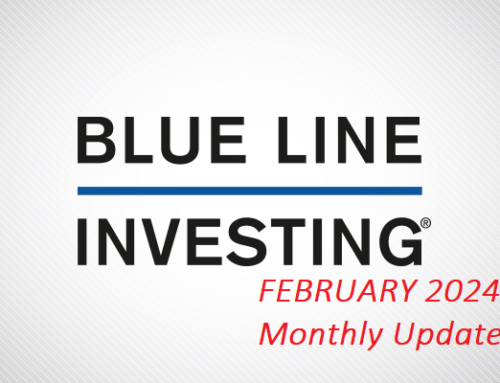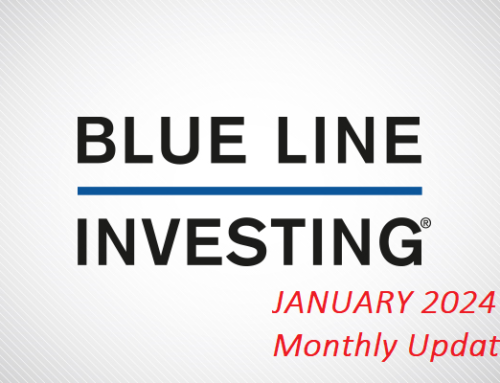Chart above courtesy of StockCharts.com
Blue Line Investing, Article 3 of 12
If you are familiar with the game of chess, the winner tends to be the player who thinks several moves ahead. Since you can’t read your opponent’s mind, you always have to modify your next planned moves as your opponent moves in order to remain ahead. This article, along with the two that follow hereafter, will provide examples of this concept using Daily, Weekly, and Monthly perspectives of the U.S. stock market.
The Daily chart (pictured above) can help an investor in 2 primary ways. First, it provides the opportunity to evaluate the short-term primary trend of an investment which helps evaluate the risk of owning it. If the trend is positive, prices will predominately remain above the blue line and rise for an extended period. If the trend is neutral, prices will predominately oscillate above and below the blue line without making any significant advancement. And if the trend is negative, prices will typically remain below the blue line and decline for an extended period.
Second, it provides the opportunity to observe technical formations that can coincide with potential changes in these trends. For instance, while it is positive that prices in the chart above of the S&P 500 Index rallied back above the blue line earlier this calendar year, and has so far been able to remain above the blue line, a technical formation recently formed called a “Head and Shoulders.” This formation, identified above with “LS” as the left shoulder, “H” as the Head, and “RS” as the right shoulder, warned that prices might correct in the short-term. Sometimes this formation results in a short-term price correction (as it did in 2011), and sometimes it can warn of a major stock market top (as it did in 1929).
So how can these short-term technical formations help you with your investment decisions? First, if you are considering adding new money to your investments, wouldn’t you rather do so after prices decline rather than right before? Second, if you are already fully invested, wouldn’t you prefer to have the choice of placing some protective hedges in your portfolio if the market may be warning of a pending correction? Third, for the aggressive investor, wouldn’t you like the opportunity of making some investments on the short side of the stock market in attempt to profit from the correction? These concepts will be discussed further in future articles.
In our next article we will explore the Weekly perspective.
Disclaimer:
Technical analysis is a method of evaluating securities by analyzing statistics generated by market activity, such as past prices and volumes. Technical analysis attempts to predict a future stock price or direction based on market trends. The assumption is that the market follows discernible patterns and if these patterns can be identified then a prediction can be made. There are certain limitations to technical analysis research, such as the risk is that markets may not always follow patterns. This investment process should not be considered a guaranteed prediction of market activity and is one of many indicators that may be used to analyze market data for investing purposes. There is no guarantee that this process will be successful or will result in the projections contained herein.
Past performance is not indicative of future results. This material is intended for educational purposes only and is not financial advice or an offer to buy or sell any product. The investment strategy discussed may not be suitable for all investors. Investors must make their own decisions based on their specific investment objectives and financial circumstances. The opinions expressed are those of Blue Line Investing and are not necessarily those of Gordon Asset Management, LLC and are subject to change without notice. Blue Line Investing reserves the right to modify its current investment strategies based on changing market dynamics or client needs. Advisory services offered through Gordon Asset Management, LLC (GAM). GAM is an SEC-registered investment adviser. Registration does not imply a certain level or skill or training. More information about the advisor, its investment strategies and objectives, is included in the firm’s Form ADV Part 2, which can be obtained, at no charge, by calling (866) 216-1920. The principle office of Gordon Asset Management, LLC is located at 1007 Slater Road, Suite 200, Durham, North Carolina, 27703.
The S&P 500 Index is the Standard & Poor’s Composite Index of 500 stocks and is one of the most commonly followed equity indices. The volatility (beta) of an account may be greater or less than the index. It is not possible to invest directly in this index.





